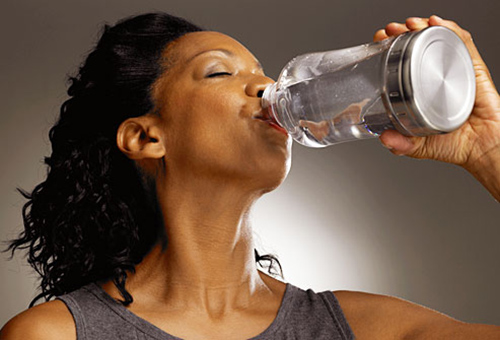Being thirsty is not the only sign you’re not drinking enough water. As a matter of fact according to medical experts, by the time you feel that urge to quench your thirst, you might already be on the verge of dehydration. Depriving your body of good old H2O can bring on a slew of health issues such as kidney problems, dizziness, and can even contribute to diseases like diabetes. On the extreme end, not taking in enough water can also lead to death. The latest guidelines from the Institute of Medicine recommend that most women consume about 91 ounces—that’s actually about 9 cups of total water a day. Men need a bit more; about 125 ounces (or 13 cups) a day. A helpful reminder to stay hydrated: keep some water right within reach and take sips every chance you get throughout the course of the day.
According to the Centers for Disease Control and Prevention, Blacks do not consume as much water as whites or Latinos and usually turn to soft drinks and other beverages that are loaded with sucrose, lots of calories, and offer no nutritional value. A lack of hydration can seriously cause damage to our bodies, so if you experience any of the following symptoms it might be time to fill up that water bottle pronto!
- Dry eyes, skin and mouth: Our bodies lose fluids every single day so we need to replenish what we lose. A lack of hydration can result in a dry mouth because there isn’t enough fluid to produce saliva. Dehydration also causes the skin to be limp, flaccid, lusterless and dry. Increasing water intake can also help decrease the annoying symptoms of dry eye syndrome.
- Headaches: You might want to think twice before grabbing a pain reliever the next time you experience a headache and opt for a tall glass of water instead. Lack of water can lower blood flow and oxygen which leads to dilated blood vessels in the brain that can increase swelling and inflammation; the end result is a headache.
- Dark urine: Your urine color is quite possibly the best indicator as to whether or not you are drinking enough water. Lighter shades of yellow indicate that you are probably well-hydrated—but as the color darkens, it could be a sign you need to refuel with fluids. If you’re noticing shades of brown in your urine, it can simply be a sign that you are dehydrated.
- Disorientation: Confusion, lethargy, difficulty, dizziness, trouble concentrating, these signs of dehydration are most common in older adults. They do not feel thirst until they are already dehydrated. As we lose fluids every day via sweating, urination, an imbalance of electrolytes (nutrients or minerals in the body) can develop. Drinking water helps to maintain balance within the body.
- Joint Pain: The cartilage and spinal discs that keep our bones from grinding together are 80 percent water and hydration, they help to ensure that joints can take the impact of sudden movements like running or falling which is why you need to drink H2O.
- Constipation: Drinking water is instrumental in detoxification. It flushes toxins and waste from the body and transports nutrients to where they are needed. Without water, the contents of your colon can dry out and get stuck, eventually causing constipation. Water is a natural lubricant that softens stool and promotes evacuation of the bowels.
- No sweating during exercise: If you’re working out and not breaking a sweat you might be headed towards heatstroke. Sweating helps to regulate our core body temp. If there isn’t enough water to produce sweat, your body can’t regulate itself which is a bad sign!
- You’re tired: When you get dehydrated, your blood becomes thicker and your heart has to expend more energy to keep oxygen and nutrients moving throughout the circulatory system. If you feel worn out often and there doesn’t seem to be a cause, drinking more water just might be the right move.











